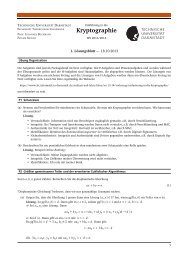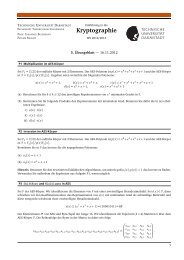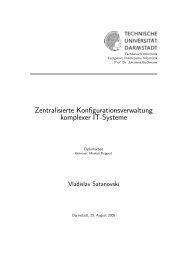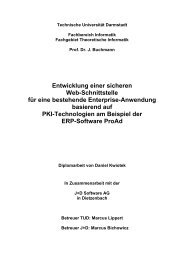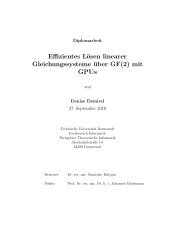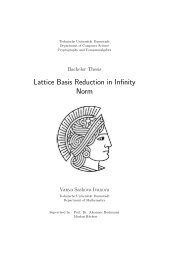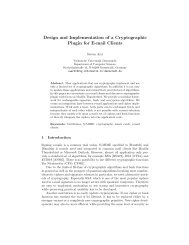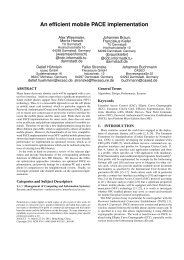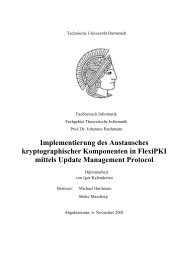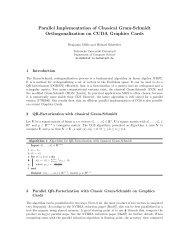Merkle Tree Traversal Techniques - CDC
Merkle Tree Traversal Techniques - CDC
Merkle Tree Traversal Techniques - CDC
You also want an ePaper? Increase the reach of your titles
YUMPU automatically turns print PDFs into web optimized ePapers that Google loves.
can be signed is limited by the size of the tree, the tree can be made arbitrarily<br />
large.<br />
2.3.2 The Lamport-Diffie one-time signature scheme: In [DH76] Whitfield Diffie<br />
and Martin E. Hellman present a new digital signature, based on hash<br />
functions. Such function Y = f ( X ) is selected. Each user U chooses 2n<br />
random values X0, X1,..., X2n− 1 and computes Y0, Y1,..., Y2n− 1 by Yi = f ( X i)<br />
.<br />
Then U publishes the vector Y = ( Y0, Y1,..., Y2n−1) in a public file under his<br />
name (i.e., in a newspaper or in a public file maintained by a trusted center).<br />
He can publish as many vectors as the number of signatures he is expected to<br />
sign. Now we come to signature generation [EB05]. Alice wants to sign an n -<br />
bit message M to Bob ( M = m0m1... mn−1). She then chooses one of his unused<br />
vectors from the public file and sends it to Bob. Bob verifies the existence of<br />
the vector in the public file. After that Alice and Bob mark the vector as used<br />
in the specific file. Alice computes the signature S= S0S1... Sn−1 by<br />
⎧ X2i, if mi<br />
= 0<br />
Si<br />
= ⎪<br />
⎨<br />
⎪<br />
⎪⎩ X2i+ 1,<br />
if mi<br />
= 1<br />
and sends it to Bob. To verify the signature, Bob computes for all i - s<br />
⎧ Y2i, if mi<br />
= 0<br />
f( Si)<br />
= ⎪<br />
⎨<br />
⎪<br />
⎪⎩ Y2i+ 1,<br />
if mi<br />
= 1<br />
Talking about the security of the signature scheme we claim that if Bob can<br />
invert the hash function f , he can then forge Alice’s signature. Even if he is<br />
given a signature of some message using some vector, he still needs to invert<br />
the hash function f in order to forge a different message using the same<br />
vector. To make this easier to understand we give the following example:<br />
Example: Let X = 01001101 and f ( X ) be a function that just changes 0-s<br />
with 1-s and vice versa. Then Y = 10110010 . Imagine that Alice wants to sign<br />
two messages M 1 = 1010 and M 2 = 1101 with this very same private key X .<br />
Then, according to the definition of the scheme, Alice computes the<br />
corresponding signatures S 1 = 1010 and S 2 = 1011,<br />
and sends them to Bob.<br />
Knowing 1 M , 2 M , 1 S and S 2 it is extremely easy for Bob to forge a new<br />
message M 3 = 1111 with its corresponding signature S 3 = 1011,<br />
just<br />
combining the previous two.<br />
11





